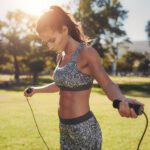Indulging at Thanksgiving dinner is as American as pumpkin pie. The holiday provides an annual excuse to feast on some of our favorite foods—juicy turkey, glorious stuffing and Mom’s famous green beans. Celebrating our culinary riches is not a bad idea. The staples of fall harvest—Brussels sprouts, sweet potatoes, cranberries—are loaded with nutrients. It’s the butter, sugar, and salt sneaking into healthy dishes that send wellness experts reeling. This year remember that simple is best for veggie sides. Hold the extra processed sugar and save the sweetness for the real desserts.
Here’s how to make choices that are as nutritious as they are satisfying for a truly Happy Thanksgiving!
Eat this: Whole-Grain Stuffing or Southern Cornbread
Whole-grain options like whole-wheat bread are a better base for Thanksgiving stuffing than white bread that offers little in the way of nutrition and flavor. The whole-grain bread’s toasty, nutty flavors are naturally more flavorful than white bread. Try Southern cornbread dressing instead of the usual white bread stuffing. Cooking homemade cornbread allows you to control the ingredients and use whole-grain cornmeal and whole-wheat flour for a more nutritious base. Both whole-grain options are full of fiber that’s filling and good for digestion and gut health.
Not that: Boxed Stuffing
Boxed stuffing is famously high in sodium with the salty taste overwhelming the fresh savory flavor.
Eat this: Roasted Sweet Potatoes
Sweet potatoes serve up lots of fiber, potassium, iron, magnesium and vitamin C. Roasting enhances the natural sweetness of sweet potatoes. Try them baked, boiled or mashed and add a tiny bit of maple syrup and a mix of traditional fall spices like cinnamon, nutmeg, and cloves.
Not that: Sweet Potato Casserole
The traditional sweet potato casserole features mashed sweet potatoes laden with butter and sugar and topped with more brown sugar and pecans or fluffy toasted marshmallows. A ridiculous amount of processed sugar added to a healthy vegetable morphs the dish into a creation that’s just this side of flat-out dessert.
Eat this: Brussel Sprouts
Brussel sprouts are rich in vitamin C, fiber and glucosinolates, a compound that may fight cancer. Roasted or sautéed brussel sprouts provide a healthy green vegetable at your table even if you sauté them with a little bacon or top them with a little cheese.
Not that: Green Bean Casserole
A traditional green bean casserole delivers a heaping spoonful of fat, calories, and salt in every bite. Search for recipes that reduce or eliminate the butter, canned cream of mushroom soup and crunchy fried onions. Pair green bean casserole with other healthy veggies to add a nice contrast of color, texture, and balance to your Thanksgiving meal.
Eat this: Fresh Cranberry Sauce
Fresh whole cranberries are rich in vitamin C and flavonoid compounds that may help prevent certain types of cancer and urinary tract infections. You’ll also get a dose of anti-inflammatory and anti-cancer properties from anthocyanin, the phytochemical that gives these berries their deep ruby-red color. Try a cranberry sauce recipe that calls for juice or apple cider to mellow the tartness of the cranberries without relying on added sugar.
Not that: Canned Cranberry Sauce
Even a serving of canned cranberry sauce that’s as small as a quarter cup delivers 6 teaspoons (or 24 grams) of sugar. Most of that sugar comes in the form of corn syrup.
Eat this: Pumpkin Pie
Pumpkin pie offers good-for-you fiber and beta carotene along with delicious natural sweetness. Keep the total sugar count low by adding maple syrup to the filling before baking for additional delicate sweetness. Spices such as cinnamon and nutmeg can enhance sweetness without piling on additional calories. Keep the classic Thanksgiving dessert healthy by skipping the whipped cream topping and ice cream. Eating it warm helps bring out all the flavors!
Not that: Pecan Pie
A generous amount of sugar and corn syrup makes traditional pecan pie a highly concentrated source of sugar and calories. The average one-eighth slice of a 9-inch pecan pie delivers about 500 calories.






